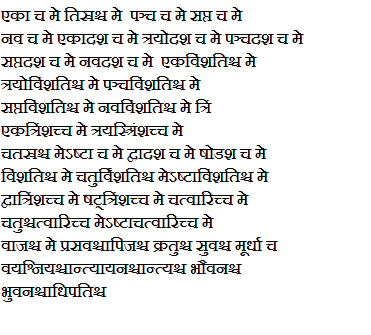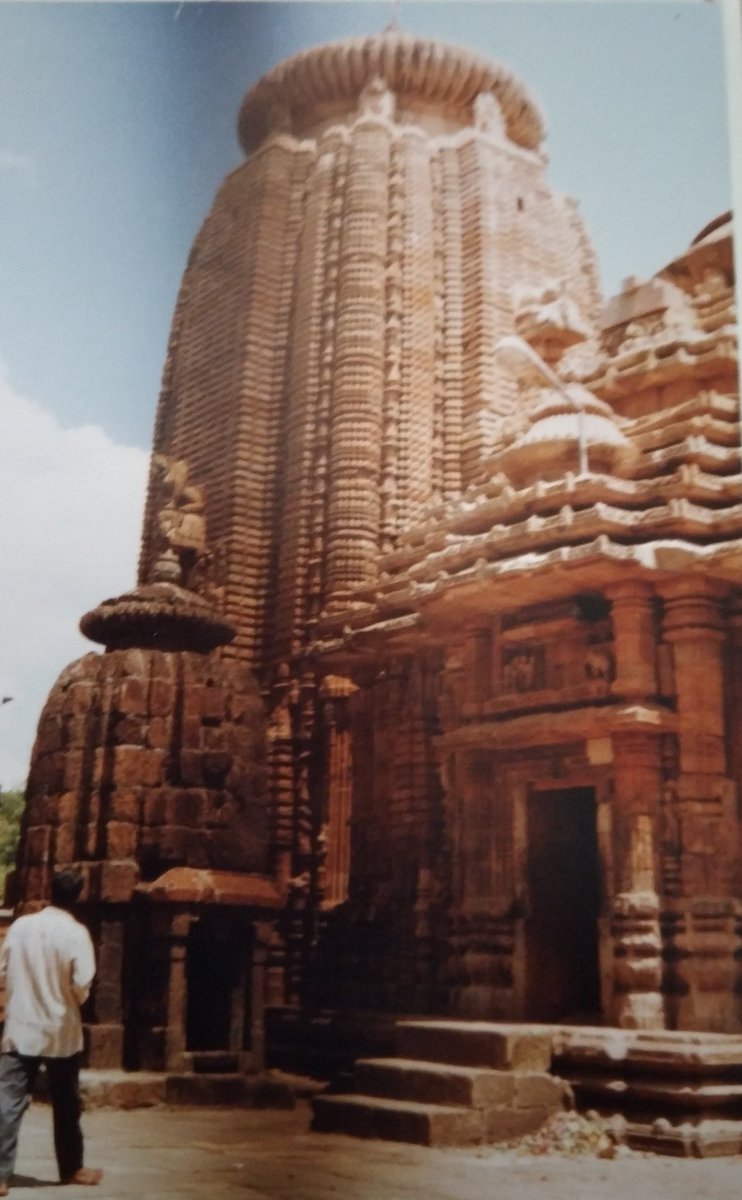The Taittariya Samhita, Chapter 7 has the #Chamakam, and the 11th Anuvaka talks about "'wanting numbers".
(1/x)

FIVE :
The five mahabhutas, or the five basic elements, that is, prithvi, apa, tejas, vayu and akasha, (earth, water, energy or agni or fire, wind and space).
(4/x)
NINE :
The nine openings in the human body (two eyes, two ears, two nostrils, one mouth, rectum and genitals), called the navadwaras.
(6/x)
ELEVEN:
The ten pranas or life forces and the Sushumna nadi.
The 10 pranas include 5 mahapranas and five laghupranas.
Mahapranas are Prana (heartbeat & breath), Apana (excretion), Vyana (muscular action), Udana (voice), Samana (digestion).
(7a/x)
The laghupranas are Naga (Burping), Koorma (Blinking) , Krikala (Sneezing), Devadatta (Yawning), Dhananjaya (Opening and closing of heart valves)
The Sushumna Nadi correlates to the central nervous system.
(7b/x)
THIRTEEN :
Thirteen Devas of Vastu mandala namely Brahma, Apa, Savitri, Jaya, Rudra, Apavatsa, Savita, Vivudhadipa, Rajayakshma, Aryama, Vivasvan, Mitra, Prithvidhara.
(From Chapter 253 of Matsya Purana)
(8/x)
FIFTEEN:
The fifteen major nadis (out of the 350,000 nadis) of the or nerve centres in the human body,including
Ida, Pingala and Sushumna Nadis.
(9/x)
SEVENTEEN:
These are the seventeen 'limbs' of the astral body or sukshma-sharira. They consist of tive attributes each from the three Gunas along with intelligence and mind.
(10a/x)
(10b/x)
(10c/x)
(10d/x)
(10e/x)
(10f/x)
NINETEEN:The 19 primary medicinal herbs of Ayurveda including Saffron(Amlika), Ashwakarna, Ailanthus Excelsa(Aralu), Lotus(Kamalam), Camphor(Karpooram), Salt Reed Grass(Kusa), Sesame(Tilam), Coconut (Narikelam) and Laurel (Plaksha) among others. (11/x)
TWENTY ONE:
The 21 important vulnerable parts of the body. These may be the bridge of the nose; above the ear; the philtrum (groove between nose and upper lip); the point of the chin; Adam's apple; the clavicle (collar bone); the armpit; ...(12a/x)
the solar plexus; the bottom ribs; the abdomen; the groin; the inner wrist; the shins; instep ( the arched part of the top of the foot between the toes and the ankle); the nape (which is the base of the cerebellum); ...(12b/x)
the upper back; the coccyx (or tailbone); hollow of the knee; the calf; the Achilles tendon. ...(12c/x)
TWENTY THREE:
The twenty three devas controlling serious diseases like Sheetala Devi (for Smallpox); Surya (for Jaundice); Jvarataharisvara (for Malaria); Mahamari (for Cholera).
(13/x)
TWENTY FIVE :
The 25 primary Apsaras in heaven including Rambha, Urvashi, Menaka, Tilottama, Sugandha, Supriya, Suraja, Surasa, Surata, Anavadya, Anuchana, Aruna, Asita, Chandrajyotsna, Indralaxmi, Kamya, ... (14a/x)
Karnika, Keshini, Kshema, Manorama, Mishrasthala, Mrugakshi, Nabhidarshana, Marichi. (14b/x)
TWENTY SEVEN:
The twenty seven tribes of Gandharvas. (Book 2, Section 11 of Mahabharata) (15/x)
TWENTY NINE:
Vidyut Devas, the embodiment of lightning, electricity or electromagnetic energy. (16/x)
THIRTY ONE:
Thirty one worlds. The traditional Hindu cosmology describes 14 worlds. However, the Buddhist cosmology talks about thirty one planes of existence, spread over three catgories.
(17a/x)
(31) Neither-perception-nor-non-perception (nevasaññanasaññayatanupaga deva)
(30) Nothingness (akiñcaññayatanupaga deva)
(29) Infinite Consciousness (viññanañcayatanupaga deva)
(28) Infinite Space (akasanañcayatanupaga deva)
(17b/x)
(27) Peerless devas (akanittha deva)
(26) Clear-sighted devas (sudassi deva)
(25) Beautiful devas (sudassa deva)
(24) Untroubled devas (atappa deva)
(23) Devas not Falling Away (aviha deva)
(22) Unconscious beings (asaññasatta)
(17c/x)
(20) Devas of Refulgent Glory (subhakinna deva)
(19) Devas of Unbounded Glory (appamanasubha deva)
(18) Devas of Limited Glory (parittasubha deva)
(17) Devas of Streaming Radiance (abhassara deva)
(17d/x)
(15) Devas of Limited Radiance (parittabha deva)
(14) Great Brahmas (Maha brahma)
(13) Ministers of Brahma (brahma-purohita deva)
(12) Retinue of Brahma (brahma-parisajja deva)
(17e/x)
** Happy states
(11) Devas Wielding Power over the Creation of Others (paranimmita-vasavatti deva)
(10) Devas Delighting in Creation (nimmanarati deva)
(9) Contented devas (tusita deva)
(8) Yama devas (yama deva)
(7) The Thirty-three Gods (tavatimsa deva)
(17f/x)
(5) Human beings (manussa loka)
** Deprived states
(4) Asuras (asura)
(3) Hungry Shades/Ghosts (peta loka)
(2) Animals (tiracchana yoni)
(1) Hell (niraya)
(17g/x)
THIRTY THREE:
The thirty three Devas (composed of eight Vasus, eleven Rudras and twelve Adityas along with Indra and Prajapati) (Brihadraranyaka Upanishad 3.9)
(18a/x)
(18b/x)
(18c/x)
Indra is the thunder and Prajapati is the sacrifice.
(18d/x)
FOUR:
The four ideals of human life, namely dharma, artha, kama and moksha,
(righteous way of life, wealth, desire, and salvation)
(19/x)
EIGHT:
The 4 Vedas (Rig, Yajus, Sama, Athava) and the four corresponding upavedas(Ayurveda-medicine, Dhanurveda-archery, Gandharvaveda-music and related arts and one of Shastrashaastra-military science or Sthapatyaveda-architecture)
(20/x)
TWELVE:
Six Vedangas and six Darshana Shastras.
Vedangas are auxiliary disciplines which are pre-requisites for proper study of the vedas.
(21a/x)
(21b/x)
(21c/x)
(21d/x)
(21e/x)
SIXTEEN:
The sixteen attributes that one can seek from God.
1. Daya – Compassion
2. Dharjya – Patience
3. Kshama – Forgiveness
4. Nyaya – Justice
5. Nirapeksha – Impartiality
6. Niraskata – Detachment
(22a/x)
8. Aparchitta – Invincibility
9. Danasheel – Beneficience, Bestower of all wealth in the world and nature.
10. Saundarjyamaya – Beauty Incarnate
11. Nrityajna – Best of Dancers
12. Sangitajna – Best of Singers
(22b/x)
14. Satyabadi – Truth Itself
15. Sarvagnata – Perfect master of all arts, such as poetry, drama, painting etc.
16. Sarvaniyanta – Controller of All
(22c/x)
TWENTY:
The Mahabhutas associated with the primary elements of Akasha (space), Vayu (air), Agni (fire), Aapa (water) and Prithvi (earth).
(23/x)
TWENTY FOUR:
The number of letters in the Gayatri chhanda or metre.
It is a metre of 3 feet or padas, of 8 syllables each, giving a total of 24 syllables. The 3 pada length is unusual. Thus, it is sometimes also called as Tripada-Gayatri.
(24/x)
TWENTY EIGHT:
The number of letters in the Ushnik chhanda or metre.
This metre is named after the 7th horse pulling Surya's chariot. It is of four padas of seven syllables each. Thus, resulting in a twenty eight syllable stanza.
(25/x)
THIRTY TWO:
The number of letters in the Anushtup chhanda or metre.
This metre is the one which is usually used at the beginning of sanskrit hymns. It is of four padas of eight syllables each. Thus, resulting in a thirty two syllable stanza.
(26a/x)
vak-ra-tun-da-ma-ha-kaa-ya
sur-ya-ko-ti-sa-ma-pra-bah:
nir-vigh-nam-ku-ru-me-de-va
sar-va-ka-rye-shu-sar-va-da
(26b/x)
THIRTY SIX:
The number of letters in the Brihati chhanda/metre.
This metre is also of 4 padas. However, all the padas are not of equal length. The third pada is of 12 syllables while the rest are of 8 syllables each, resulting in 36 syllables.
(27/x)
FORTY:
The number of letters in the Pankti chhanda or metre.
This metre is of five padas, instead of the usual four. Each pada is of eight syllables each. Thus, resulting in a forty syllable stanza.
(28/x)
FORTY FOUR:
The number of letters in the Trushtup chhanda or metre.
This metre is of four padas. Each pada is of eleven syllables each. Thus, resulting in a forty four syllable stanza.
(29/x)
FORTY EIGHT:
The number of letters in the Jagati chhanda or metre.
This metre is of four padas. Each pada is of twelve syllables each. Thus, resulting in a forty eight syllable stanza.
(30/x)











